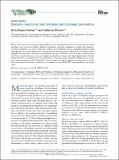Salivary mucins in host defense and disease prevention
Author(s)
Frenkel, Erica Shapiro; Ribbeck, Katharina
DownloadFrenkel-2015-Salivary mucins in h.pdf (558.8Kb)
OPEN_ACCESS_POLICY
Open Access Policy
Creative Commons Attribution-Noncommercial-Share Alike
Terms of use
Metadata
Show full item recordAbstract
Mucus forms a protective coating on wet epithelial surfaces throughout the body that houses the microbiota and plays a key role in host defense. Mucins, the primary structural components of mucus that creates its viscoelastic properties, are critical components of the gel layer that protect against invading pathogens. Altered mucin production has been implicated in diseases such as ulcerative colitis, asthma, and cystic fibrosis, which highlights the importance of mucins in maintaining homeostasis. Different types of mucins exist throughout the body in various locations such as the gastrointestinal tract, lungs, and female genital tract, but this review will focus on mucins in the oral cavity. Salivary mucin structure, localization within the oral cavity, and defense mechanisms will be discussed. These concepts will then be applied to present what is known about the protective function of mucins in oral diseases such as HIV/AIDS, oral candidiasis, and dental caries.
Date issued
2015-12Department
Massachusetts Institute of Technology. Department of Biological EngineeringJournal
Journal of Oral Microbiology
Publisher
Co-Action Publishing
Citation
Frenkel, Erica Shapiro, and Katharina Ribbeck. “Salivary Mucins in Host Defense and Disease Prevention.” Journal of Oral Microbiology 7, no. 0 (December 22, 2015).
Version: Final published version
ISSN
2000-2297
